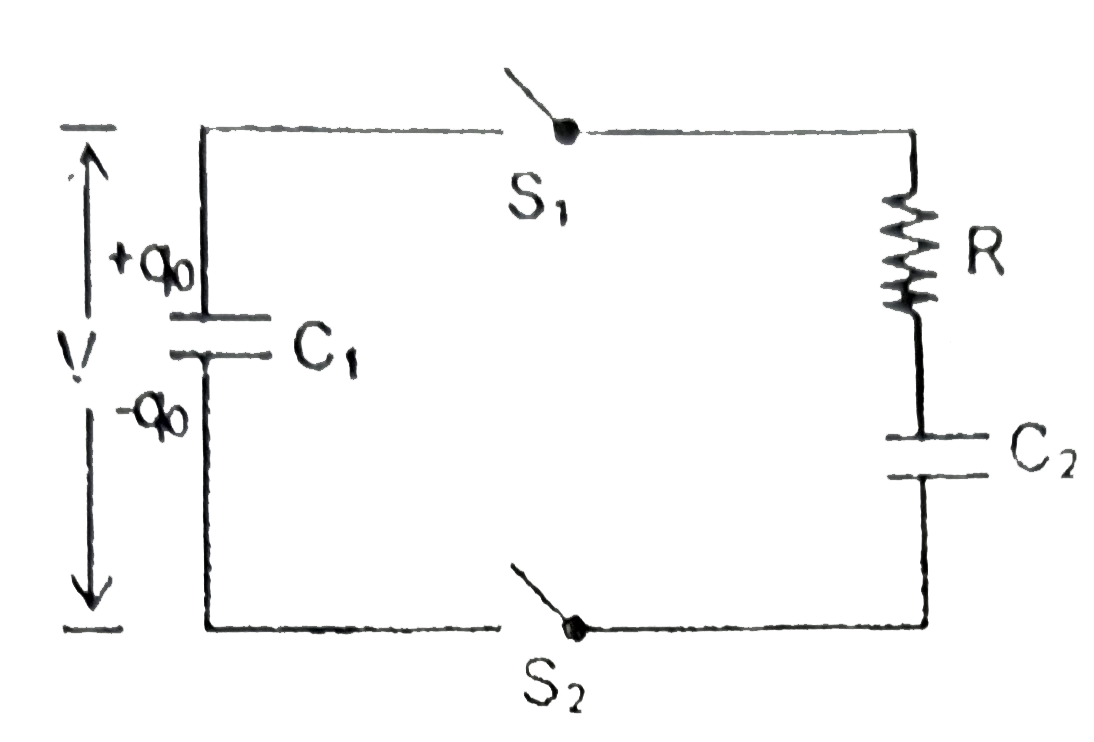The capacitor C1 in the figure shown initially carries a charge q0. When the switches S1 and S2 are closed, capacitor C1 is connected in series to a resistor R and a second capacitor C2 which is initially uncharged.

the total head dissipated in the circuit during the discharging process of C1 is
q202C21×C
q202C
q20C22C21
q202C1C2
The correct Answer is:A
Common potential in steady state when they finnaly come in parallel is
V=Total chargeTotal capacity=q0C1+C2
total heat dissipated =Ui−Uf
=q202C1−12(C1+C2)(q0C1+C3)2
=(q202C1)(C1C2C1+C2)
Topper's Solved these Questions
- CAPACITORSBOOK - DC PANDEYCHAPTER - CAPACITORSEXERCISE - OBJECTIVE_TYPE
1 Videos
- CAPACITORSBOOK - DC PANDEYCHAPTER - CAPACITORSEXERCISE - OBJECTIVE_TYPE
1 Videos
- ATOMSBOOK - DC PANDEYCHAPTER - ATOMSEXERCISE - MEDICAL ENTRANCES GALLERY
42 Videos
- COMMUNICATION SYSTEMBOOK - DC PANDEYCHAPTER - COMMUNICATION SYSTEMEXERCISE - Subjective
11 Videos
Similar Questions
The capacitor C1 in the figure initially carries a charge q0. When the switch S1 and S2 are shut, capacitor C1 is connected in series to a resistor R and a second capacitor C2, which initially does not carry any charge.
If the heat lost in the resistor after a long time of closing the switch is q20C2kC1(C1+C2), then Find the value of k.

View SolutionThe capactor C1 in the figure initially carries a charge q0. When the i switch S1 and S2 are closed, capacitor C1 is connected to a resistor R and a second capacitor C2, which initially does not carry any charge.
(a) Find the charges deposited on the capacitors in steady state and the current through R as a function of time.
(b) What is heat lost in the resistor after a long time of closing the switch?

View Solution
Knowledge Check
The capacitor C1 in the figure shown initially carries a charge q0. When the switches S1 and S2 are closed, capacitor C1 is connected in series to a resistor R and a second capacitor C2 which is initially uncharged.

The charge flown through wires as a function of time is
where C=C1C2C1+C2Aq0e−tRC+CC2q0Bq0CC1x[1−e−tRC]Cq0CC1e−tCRDq0e−tRCIn the circuit shown initially C1,C2are uncharged. After closing the switch
 AThe charge on C2 is greater that on C1BThe charge on C1 and C2 are the sameCThe potential drops across C1 and C2 are the sameDThe potential drops across C2 is greater than that across C1
AThe charge on C2 is greater that on C1BThe charge on C1 and C2 are the sameCThe potential drops across C1 and C2 are the sameDThe potential drops across C2 is greater than that across C1In the circuit shown initially C1,C2 are uncharged. After closing the switch
 AThe charge on C2 is greater that on C1BThe charge on C1 and C2 are the sameCThe potential drops across C1 and C2 are the sameDThe potential drops across C2 is greater than that across C1
AThe charge on C2 is greater that on C1BThe charge on C1 and C2 are the sameCThe potential drops across C1 and C2 are the sameDThe potential drops across C2 is greater than that across C1
A capacitor of capacitance C, which is initially uncharged , is connected with a battery of emf ε. Find the heat dissipated in the circuit during the process of charging .
View SolutionIn the circuit shown. Initially the capacitor is uncharged. The switch S is closed at time t=0. Then

View SolutionIn the circuit shown, the capacitor C1 is initially charged with charge q0. The switch S is closed at time t = 0 . The charge on C2 after time t is

View SolutionA capacitor having initial charge q0=CE/2 is connected to a cell of emf E through a resistor R as shown. Find the total heat generated in the circuit after the switch S is closed.

View SolutionIn the circuit shown in the figure, the capacitor C is charged to a potential Vo. The heat generated in the circuit when the switch S is closed, is
View Solution
